Just a few days ago, I set out early in the morning on a misty walk. On my gallery today, I posted a photo taken in that same mist: a dried-up flower covered with cobwebs and dew, creating a jewel-like effect. Since my goal was to capture “misty scenes,” I hadn’t packed any telephoto lenses. Instead, I carried only my sturdy Olympus E-M1X with the 12-40mm Pro lens. As always, whether hiking or cycling through the woods, I stay alert and in silent mode—anything else, and the wildlife vanishes before you can even spot it.
Then, suddenly, a deer appeared, about 10 to 15 meters away. Normally, I keep my trusty Olympus TG-4 or TG-5 in my pocket, as they offer a bit of zoom. But this time, I was limited to the 40mm max on my setup. At first, the deer was another five meters or so beyond that, but by moving slowly and carefully, I managed to get closer and capture two shots. I cropped them to 16:9 at 2500px from the original 4:3 5232px files. You’ll find both versions in my gallery below, with the originals resized to 1920px for web display.
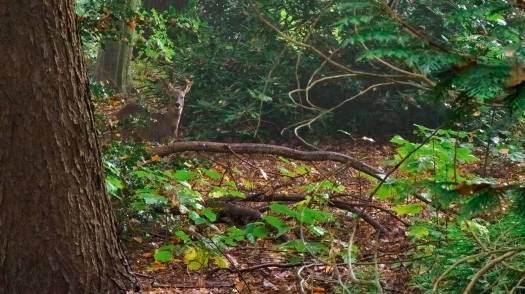
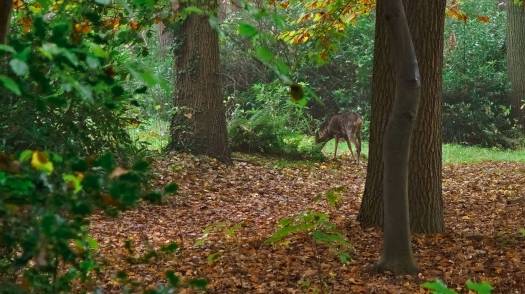
Above 16/9 crops – about 50% of the original
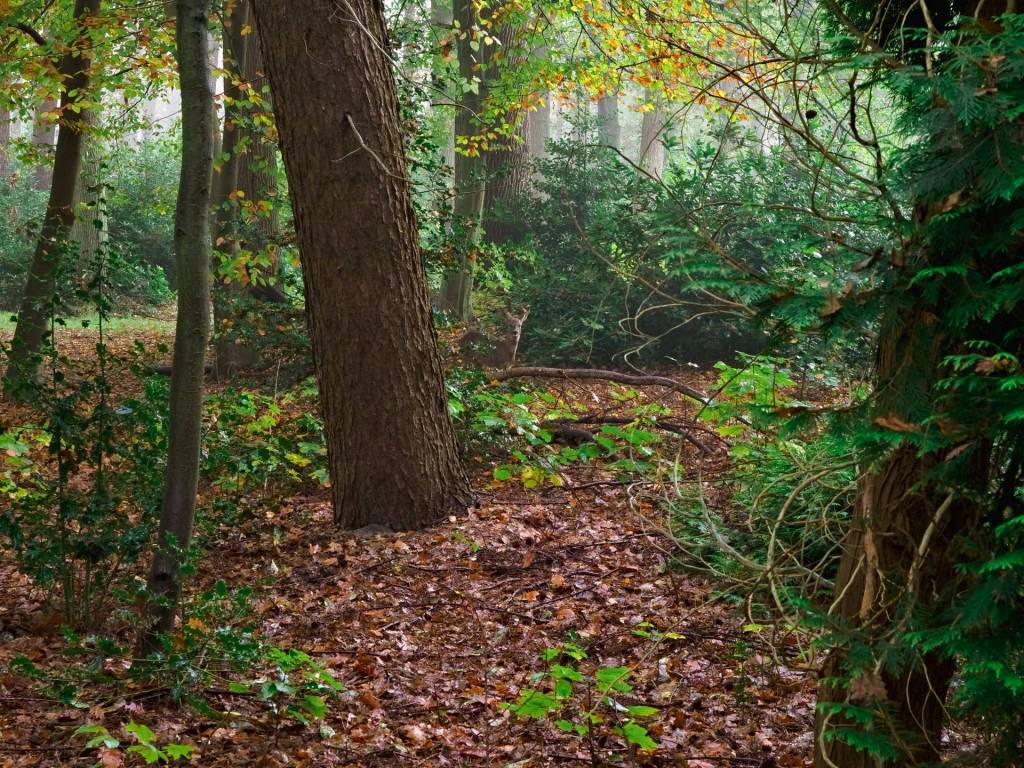
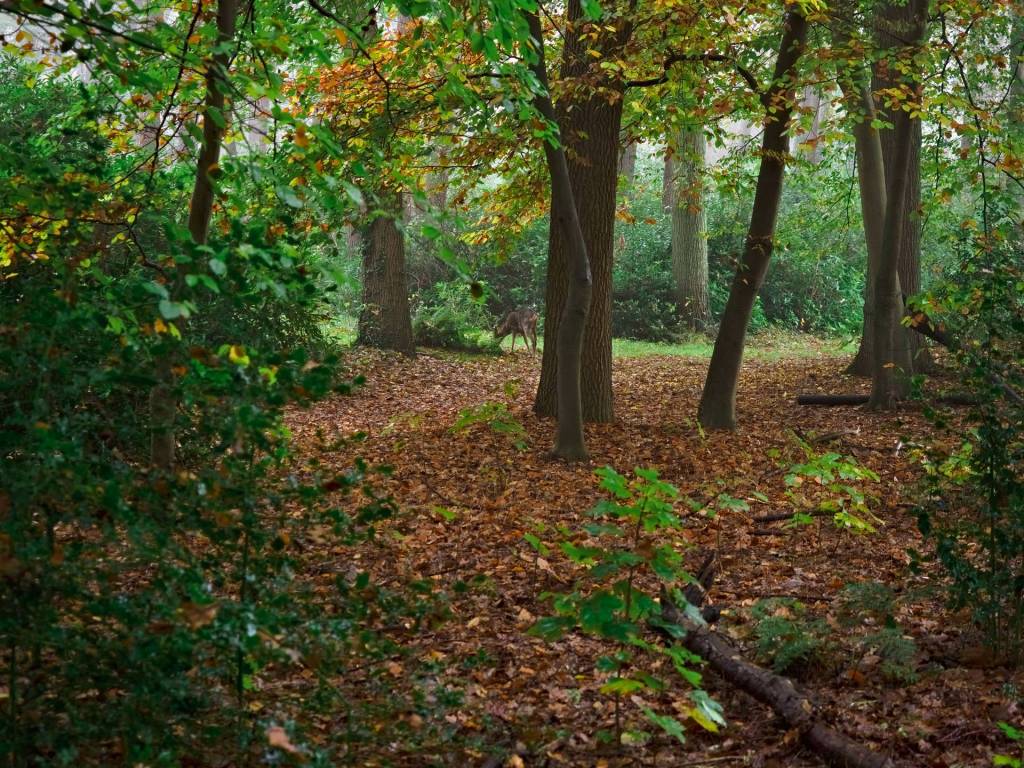
Above original 4/3 pictures resized to 1920px
I’ve come to realize that cropped photos aren’t as bad as I once thought. But the real purpose of this post is to show that even with a smaller focal length, you can still capture beautiful photos of deer. It’s not necessarily an expensive camera with a massive zoom lens that will get you great wildlife shots—in fact, my experience has shown that the further away your subject is, the less impactful the photo often becomes. Several factors play into this:
- Optical limitations at long distances – lenses may lose detail when shooting from afar.
- Shallow depth of field – achieving a pleasing depth of field over long distances is challenging.
- Atmospheric conditions – extreme weather, whether too hot or too cold, can distort or degrade image quality.
- Your own physical condition – heavy breathing or minor movements can blur shots.
- Camera settings – using a shutter speed that’s too low or an ISO that’s too high can also reduce quality.
While technical skills and gear are essential, what makes the biggest difference is how you behave when you’re out “hunting” with your camera. Moving slowly, staying quiet, and, perhaps most importantly, wearing camouflage make a big impact.
Tips for Wildlife Camouflage
Wear earth tones—browns, greens, anything that blends in with the natural surroundings. Hunting clothing is excellent for this; it’s often designed to withstand cold and wet conditions. Military gear is even better. If you stand still, deer can barely see you, although they’ll still be able to smell you. I once had a roe deer come within just a few meters to sniff and investigate what I was. For about ten minutes, the deer crept closer, and though I didn’t take any photos, the experience itself was worth a thousand pictures.
With age, I’ve come to appreciate natural fabrics like merino wool, which is ideal for outdoor activities. It insulates well, manages moisture effectively, and outperforms fleece, which can make you overheat.
Most of my older hunting clothes come from Decathlon (sometimes branded as Solognac), which is available in many countries.
You can also find military gear at surplus shops or army surplus stores. My favorite supplier today for military, hunting, and outdoor clothing is Varusteleka in Finland, which has reasonable shipping costs.
Of course, you’ll likely find local or online stores in your area for similar clothing and gear.
Hope you find this helpful! I’ll be back on Monday with a new article. Have a great weekend, everyone!
Update 15:00 24/11/24 : A good friend of mine reminded me of something interesting and quite popular among certain photographers: fishing vests. These sleeveless vests come in a variety of colors, including beige, green, brown, and camouflage, and are packed with numerous pockets to store all sorts of gear.
One of the great advantages of these vests is that you can easily wear them over your regular clothing. They help break up the shape and color of your outfit, allowing you to blend in a bit more and stay less noticeable.
Thanks for the tip, Ted!
Discover more from Open Source Photography
Subscribe to get the latest posts sent to your email.


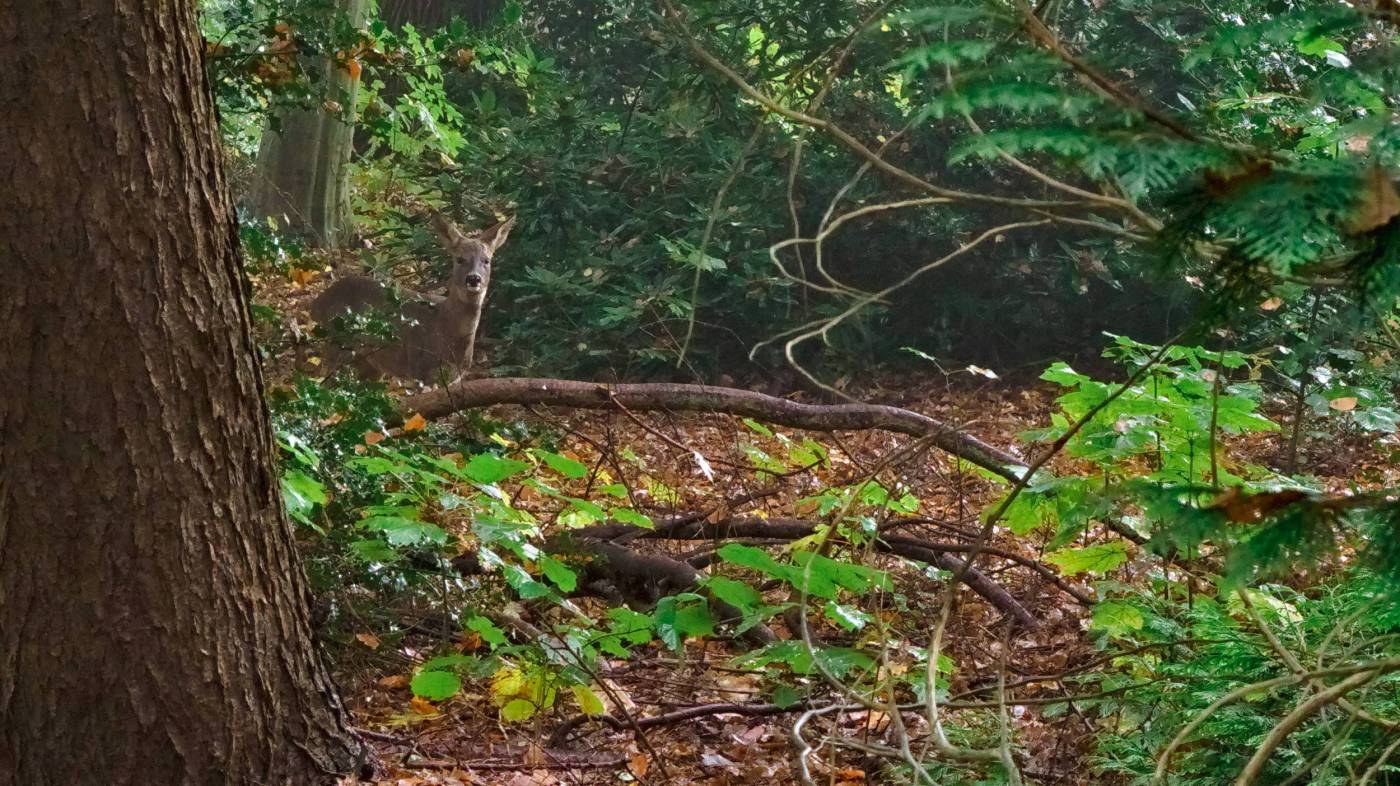

daar moet je oog voor hebben Marc
op naar een prettig weekend
LikeLiked by 1 person
Dankjewel Willy ! ook voor u een fijn weekend !
LikeLike
Good tips and excellent photos. I used Olympus I have the em1 MK2 and em5 MK1 as a spare (a truly superb and underrated camera). I ditched the heavy Nikon’s a couple of years ago and love the m43 format.
LikeLiked by 1 person
Dear James,
Thank you so much for your feedback—I truly appreciate it.
As you mentioned, it’s a shame that so many people tend to underrate the entire Micro 4/3 system. It actually has many advantages, not least of which are its compact size and light weight.
Thanks again, and have a great weekend!
All the best,
Marc
LikeLiked by 1 person
Another nice thing about wearing the proper clothing is pockets… deep and lots of them. If you don’t mind being the complete nerd a fishing/hunting vest offers incredible amounts of ‘mobile storage’.
LikeLiked by 1 person
Hi Ted,
After I finished and published the article, I started wondering if I’d forgotten something—and believe it or not, the one thing I thought of afterward was a fishing vest! Some people even call them “photog vests” ,probably because photographers used to use them to store film rolls and other gear. So, you hit the nail right on the head! I definitely should have included it.
Thanks so much for thinking along with me; I could have completely missed it.
Thanks again, and have a wonderful weekend!
Marc
LikeLiked by 1 person
LOL,
LikeLiked by 1 person
Wauw dat is geluk hebben en het zien!
LikeLiked by 1 person
één van mijn kleinkids zegt dat ook altijd “bompa, hoe komt het dat gij alles ziet” – ogen opentrekken jongen en zwijgen zeg ik dan altijd 🙂 Alle geheid op een stokje, het is niet de eerste keer dat ik mensen voorbij een hert of iets anders zie lopen zonder het gezien te hebben, gewoon omdat ze teveel met elkaar bezig zijn en niet met de natuur. Fijn weekend !
LikeLiked by 1 person
Zo is dat!
LikeLiked by 1 person
It is always good to spot the elusive deer in the forest, Marc. In 3 seasons, we are torn by the need to make noise so as to not surprise a bear and the need to be quiet so we can spot deer, etc. In the winter, there is little hope as walking on the snowy path is seldom quiet. Have a great Friday. Allan
LikeLike
For some reason, your message ended up in spam. Sometimes, I really don’t understand how WordPress can make such a silly mistake.
It’s funny that you have to make noise for safety against bears, but at the same time, it scares away all the other wildlife too. Luckily, we don’t have bears here!
Have a great day, Allan!
LikeLiked by 1 person
I’m amazed by your tips 🙂 The pictures are lovely! So close! Our deer are much more “jumpy” 🙂
LikeLiked by 1 person
Thank you, Ilze! Actually, that wasn’t taken up close, and it was shot with a pocket camera. My photos are hosted on a separate website I maintain specifically for them. The site you’re visiting now is my technical page.
If you ever have some time, feel free to visit my photography site here : https://marcroovers.wordpress.com/ You can search for “deer” there or just browse around. 😊
Have a nice Friday evening with your family !
Marc.
LikeLiked by 1 person
I was in for a treat! Thank you for sharing your photography site! Loved it! Followed it!
LikeLiked by 1 person
also a short video here : https://youtu.be/cy556TfdaIg?feature=shared
LikeLike
🙂 How close were you?
LikeLiked by 1 person
that one, about 10-12 meter, and he didn’t even know I was standing there – but in full camo gear.
LikeLiked by 1 person
Wait, were you wearing camouflage or sitting under it? How long were you out there?
LikeLiked by 1 person
Wearing camo – in most cases military style, and the deer think i’m a bush 🙂 – most of times an hour or two at one place
LikeLiked by 1 person
Wow, 1 to 2 hours is something I just can’t manage—I have a hard time sitting still! 🙂 Do you have a blog post about camouflage that you’d recommend?
LikeLiked by 1 person
To start, I also camouflage my lenses—you can read more about that here : /2024/06/17/chasing-birds-lenscamo-lens-protection-review/. I’ve touched on this topic before, but it’s a tricky subject. Military-style clothing isn’t always socially acceptable, though that doesn’t bother me much.
In the past, I mostly used hunting gear from Decathlon, but nowadays, I prefer a mix: hunting pants combined with military jackets. This combination provides even better camouflage when out in nature. In winter, I add a camo beanie, and my lenses are camouflaged as well. For comfort, I use a WWII-era cotton tarp to lie on, along with a drink or a thermos in winter—then I’m good to go.
My go-to store for clothing and gear is Varusteleka.com, a Finnish online retailer. I order everything online, and it’s conveniently delivered to my door by the Belgian postal service.
LikeLiked by 1 person
This is my standard jacket : https://www.varusteleka.com/en/product/british-cs95-windproof-smock-dpm-surplus/29501 – With this type of jacket and a pair of brown or neutral waterproof pants, a deer might just mistake you for a bush. Once, one even got as close as three or four meters! But with a moose or something like that? Yeah, I wouldn’t push my luck. 😊
LikeLiked by 1 person
I don’t think I’m brave enough for that! 🙂 I do have a long moss-green puff coat with a huge hood, but the problem is that the fields are gray now—and in winter, they’ll be white. Looks like I might need three different sets of camouflage to blend in! 🙂
LikeLiked by 1 person
Well, I can understand that, but it doesn’t have to be military at all. The main goal is to break up your outline. Ordinary clothing works just fine, as long as you pay attention to the colors.
As for having multiple outfits—well, that’s not really necessary either. Even in a snowy landscape, there are green pine trees and brown logs. So, if you resemble a tree or a bush, even in the middle of the snow, animals won’t immediately think you’re human. Sure, they can smell you! But if they’re visually confused by what they see, they usually won’t run away.
LikeLiked by 1 person
That’s such a great point! Breaking up your outline really is the key, isn’t it? I hadn’t thought about how versatile ordinary clothing can be for blending in—it’s all about using the right colors and patterns.
I love the idea of resembling a tree or bush even in snowy surroundings. Nature provides all the inspiration you need! It’s fascinating how animals rely so much on visual cues, and if they’re not sure what they’re seeing, they might stick around a little longer. Maybe I should experiment with some earthy tones next time—I’ll just have to make sure the deer don’t laugh at my attempt to look like a shrub! 😊
LikeLiked by 1 person